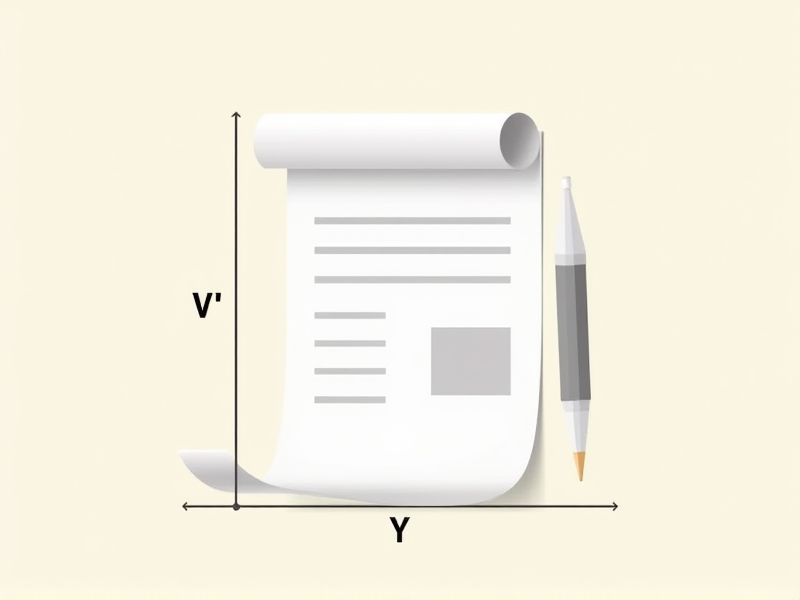
Legal documents are typically formatted on standard-sized paper, most commonly 8.5 x 11 inches (also known as "letter size") in the United States. The standard margin settings are usually 1 inch on all sides to allow space for binding and notes. Commonly, a font size of 12-point and a clear, readable typeface such as Times New Roman or Arial are used for better legibility. Consistent formatting of these elements ensures that the legal document is professional, easy to review, and complies with court or institutional requirements.
Letter Size (8.5 X 11 Inches)
Legal documents typically adhere to the standard letter size of 8.5 x 11 inches, providing a uniform format for readability and organization. This size accommodates essential elements like headings, text, and footer information within a structured layout. Organizations often mandate this format to ensure compliance and facilitate easy distribution, whether in physical or digital platforms. By using this standard, you can streamline the creation and sharing of legal documents, minimizing confusion regarding size and formatting.
Legal Size (8.5 X 14 Inches)
The standard legal document measures 8.5 x 14 inches, which is commonly referred to as legal size paper. This format is widely utilized in legal proceedings, contracts, and significant documents requiring ample space for detailed information. Your legal documents should be formatted to accommodate this size to ensure readability and compliance with legal standards. Keeping an organized layout on legal sized paper enhances clarity and facilitates the efficient processing of legal information.
Tabloid Size (11 X 17 Inches)
Legal documents designed for a tabloid size, measuring 11 x 17 inches, provide ample space for detailed formatting and readability. This size is particularly beneficial for larger graphics, charts, or extensive legal text, ensuring that all information is clearly presented without clutter. You can enhance your document's effectiveness by utilizing appropriate margins and font sizes that align with legal standards while maximizing the available area. Properly formatted tabloid legal documents can improve comprehension and retention of key information, making them essential for effective communication in legal proceedings.
A4 Size (210 X 297 Mm)
The standard size for legal documents is A4, measuring 210 x 297 mm, which is widely recognized in legal practices. This dimension ensures consistency and professionalism in the presentation of documents, making them easy to file and store. When preparing legal papers, using this format allows for clear readability and proper formatting, essential for maintaining legal integrity. Ensuring your documents adhere to A4 specifications can streamline the review process in legal proceedings.
Margins And Spacing
Legal documents typically require 1-inch margins on all sides to ensure readability and compliance with court guidelines. Line spacing is often set to double for clarity, allowing judges and other parties to easily annotate and review the content. Each paragraph should be indented by 0.5 inches, with a space between paragraphs to visually separate distinct sections. Using a standard font size, such as 12-point Times New Roman, enhances legibility, thereby facilitating effective communication in legal contexts.
Font Type And Size
Legal documents typically require a font type such as Times New Roman or Arial, ensuring clarity and professionalism. The standard font size for body text is usually set at 12-point, while headings may range from 14-point to 16-point for emphasis. Margins are generally 1 inch on all sides, promoting readability and uniformity. Adhering to these guidelines can enhance the presentation of your legal documents, ensuring they meet court standards and facilitate comprehension.
Header And Footer Guidelines
Legal documents must adhere to specific header and footer guidelines to ensure uniformity and professionalism. The header typically includes the document title, case number, and date, aligned correctly to enhance readability, while font sizes should remain consistent, often in 12-point Times New Roman or Arial. Footers generally contain page numbers, which should be centered or right-aligned, and may also include disclaimers or brief identifiers for the parties involved. Maintaining these standards across all pages can significantly improve the document's presentation and effectiveness in legal proceedings.
Column And Grid Layout
A column and grid layout in legal documents enhances readability and organization, typically featuring a three-column setup to efficiently present text and data. This layout allows for clearer delineation of sections, making it easier for readers to locate critical information, such as clauses and references. Utilizing a grid system can streamline the document's structure, leading to a more professional appearance and improved comprehension. For optimal visual impact, consider using a uniform font size of 12-point and adequate spacing around text blocks to maintain clarity.
Binding Edge Considerations
Binding edge considerations in legal documents emphasize the importance of clear, enforceable terms that protect all parties involved. Effective documents typically include clearly defined obligations, rights, and responsibilities, often requiring precise language that reduces ambiguity. According to legal standards, a binding agreement often necessitates mutual consent, meaning that both parties must agree to the terms, which ideally should be documented in writing. You should ensure that your legal documents incorporate provisions for dispute resolution and remedies, safeguarding against potential future disagreements.
Page Numbering Rules
In legal documents, page numbering is critical for organization and reference, typically starting on the second page, leaving the first page unnumbered. You should use Arabic numerals (1, 2, 3) for ease of reading, aligning numbers in the footer or header for consistency. Each section or exhibit may have a separate numbering scheme, indicated by letters or Roman numerals (e.g., A, I) for clarity. Overall, maintaining a clear pagination format enhances document navigation and ensures compliance with legal standards.
